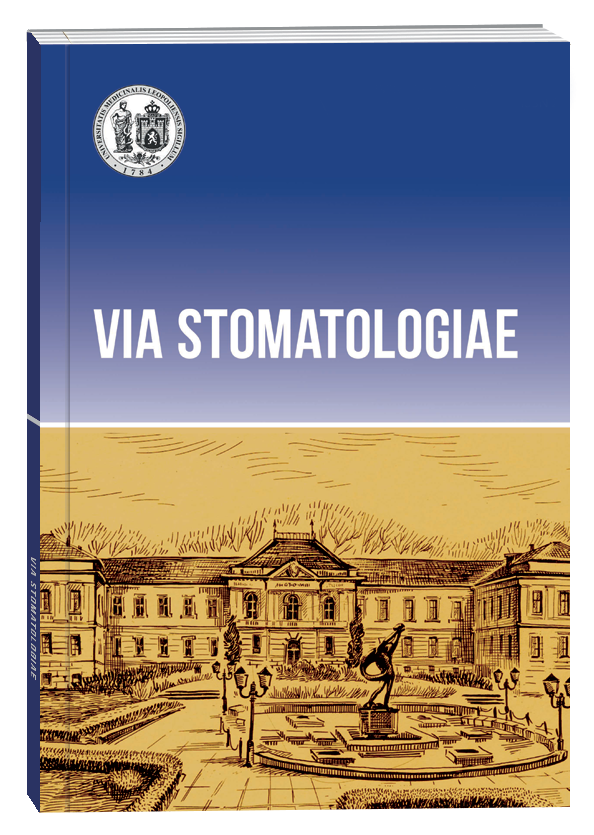CLINICAL EVALUATION OF THE EFFECTIVENESS OF THE APPLICATION OF HYDROGELS SATURATED WITH SILVER IONS AND ANTIOXIDANT PREPARATION FOR THE LOCAL TREATMENT OF ODONTOGENEOUS INFLAMMATORY PROCESSES
DOI:
https://doi.org/10.32782/3041-1394.2024-3.12Keywords:
wound healing, hydrogel dressings, odontogenic abscesses and phlegmons, antioxidant drugAbstract
Introduction. The prevalence of odontogenic abscesses and phlegmons remains high. They are characterized by the severity of the course, antibiotic resistance, and the development of severe complications. Known methods of postoperative local treatment of the indicated pathological processes have a number of shortcomings and are not always highly effective. Among such options for improving the management of postoperative treatment of purulent-inflammatory wounds, it is worth considering the use of hydrogel dressings. The aim of the study. To evaluate the clinical effectiveness of the use of hydrogels for the local treatment of odontogenic abscesses and phlegmon. Research materials and methods. 50 patients with odontogenic abscesses and maxillofacial phlegmons were divided into two groups. The comparison group (20 patients) - used standard treatment, which involved opening the inflammatory focus, evacuation of purulent exudate and drainage of the abscess. The main group (30 patients) - for dressings, hydrogel bandages saturated with silver ions and an antioxidant drug were used. During the clinical assessment of wound healing, the timing of the disappearance of perifocal edema, the cessation of exudate, the appearance of single granulations, filling with mature granulations, and the appearance of marginal epithelization were taken into account. Research results and their discussion. The cessation of purulent exudate was stopped approximately 1.5 days faster in patients of the main group (2.5±0.4 days) than in patients of the control group (3.9±0.5 days). The appearance of single granulations was observed at 4.8±0.3 days in patients of the main group. The appearance of individual granulations and the filling of the wound with young granulation tissue occurred at 6.5±0.4 days. Filling with mature granulation tissue occurred at 5.9±0.6 in the main group and at 7.8±0.5 days in the control group. The appearance of marginal epithelization in patients who were treated with silver ions and an antioxidant drug for local treatment was noted at 6.7±0.5 days, which is almost two days faster than in the control group (8.9±0.3 days). Healing times were statistically significantly reduced by an average of 25% compared to classical therapy. Thus, exudate cleansing occurred 36% faster in the main group. The appearance of single and mature granulations was noted 24% and 26% faster, compared to the comparison group. The beginning of marginal epithelization of wounds was 25% faster in patients of the main group. Conclusions. Cleansing the wound of necrotic tissues, stopping the release of purulent exudate, the appearance of granulations, the reduction of collateral edema indicates the transition from the exudation phase to the proliferative phase, which occurred in a much shorter time in the main group than in the comparison group.
References
Cuevas-Gonzalez MV, Mungarro-Cornejo GA, Espinosa-Cristóbal LF, Donohue-Cornejo A, Carrillo KLT, Acuña RAS, et al. Antimicrobial resistance in odontogenic infections: A protocol for systematic review. Medicine (Baltimore). 2022 Dec 16; 101(50): e31345. doi: 10.1097/MD.0000000000031345.
Heikkinen J, Jokihaka V, Nurminen J, Jussila V, Velhonoja J, Irjala H, et al. MRI of odontogenic maxillofacial infections: diagnostic accuracy and reliability. Oral Radiol. 2023 Apr; 39(2):364-71. doi: 10.1007/s11282-022-00646-7.
Kamiński B, Błochowiak K, Kołomański K, Sikora M, Karwan S, Chlubek D. Oral and Maxillofacial Infections-A Bacterial and Clinical Cross-Section. J Clin Med. 2022 May 12; 11(10):2731. doi: 10.3390/jcm11102731.
Keswani ES, Venkateshwar G. Odontogenic Maxillofacial Space Infections: A 5-Year Retrospective Review in Navi Mumbai. J Maxillofac Oral Surg. 2019 Sep; 18(3):345-53. doi: 10.1007/s12663-018-1152-x.
Neal TW, Schlieve Th. Complications of Severe Odontogenic Infections: A Review. Biology (Basel). 2022 Dec 8; 11(12): 1784. doi: 10.3390/biology11121784.
Welsh LW, Welsh JJ, Kelly JJ. Massive orofacial abscesses of dental origin. Ann Otol Rhinol Laryngol. 1991 Sep; 100(9 Pt 1):768-73. doi: 10.1177/000348949110000915.
Malanchuk V, Sidoryako A, Vardzhapetian S. Modern treatment methods of phlegmon in the maxillo-facial area and neck. Georgian Med News. 2019 Sep; 9(294):57–61.
Taub D, Yampolsky A, Diecidue R, Gold L. Controversies in the Management of Oral and Maxillofacial Infections. Oral Maxillofac Surg Clin North Am. 2017 Nov; 29(4):465-73. doi: 10.1016/j.coms.2017.06.004.
Weise H, Naros A, Weise C, Reinert S, Hoefert S. Severe odontogenic infections with septic progress - a constant and increasing challenge: a retrospective analysis. BMC Oral Health. 2019 Aug 2; 19(1):173. doi: 10.1186/s12903-019-0866-6.
Weyh AM, Dolan JM, Busby EM, Smith SE, Parsons ME, Norse AB, et al. Validated image ordering guidelines for odontogenic infections. Int J Oral Maxillofac Surg. 2021 May; 50(5):627-34. doi: 10.1016/j.ijom.2020.09.018.
Ko HH, Chien WC, Lin YH, Chung ChH, Cheng ShJ. Examining the correlation between diabetes and odontogenic infection: A nationwide, retrospective, matched-cohort study in Taiwan. PLoS One. 2017 Jun 8;12(6): e0178941. E | https://doi.org/10.1371/journal.pone.0178941.
Liang Y, He J, Guo B. Functional Hydrogels as Wound Dressing to Enhance Wound Healing. ACS Nano. 2021 Aug 24; 15(8):12687-722. doi: 10.1021/acsnano.1c04206.
Qi L, Zhang Ch, Wang B, Yin J, Yan Sh. Progress in Hydrogels for Skin Wound Repair. Macromol Biosci. 2022 Jul; 22(7): e2100475. doi: 10.1002/mabi.202100475.
Wang H, Xu Z, Zhao M, Liu G, Wu J. Advances of hydrogel dressings in diabetic wounds. Biomater Sci. 2021 Mar 10; 9(5):1530-46. doi: 10.1039/d0bm01747g.
Zhang A, Liu Y, Qin D, Sun M, Wang T, Chen X. Research status of self-healing hydrogel for wound management: A review. Int J Biol Macromol. 2020 Dec 1; 164:2108-23. doi: 10.1016/j.ijbiomac.2020.08.109.
Francesko A, Petkova P, Tzanov T. Hydrogel Dressings for Advanced Wound Management. Curr Med Chem. 2018; 25(41):5782-97. doi: 10.2174/0929867324666170920161246.
Ghandforoushan P, Golafshan N, Kadumudi FB, Castilho M, Dolatshahi-Pirouz A, Orive G. Injectable and adhesive hydrogels for dealing with wounds. Expert Opin Biol Ther. 2022 Apr; 22(4):519-33. doi: 10.1080/14712598.2022.2008353.
Liang Y, Zhao X, Hu T, Han Y, Guo B. Musselinspired, antibacterial, conductive, antioxidant, injectable composite hydrogel wound dressing to promote the regeneration of infected skin. J Colloid Interface Sci. 2019 Nov 15; 556:514-28. doi: 10.1016/j.jcis.2019.08.083.
Qu J, Zhao X, Liang Y, Zhang T, Ma PX, Guo B. Antibacterial adhesive injectable hydrogels with rapid self-healing, extensibility and compressibility as wound dressing for joints skin wound healing. Biomaterials. 2018 Nov; 183:185-99. doi: 10.1016/j.biomaterials.2018.08.044.
Zhao X, Wu H, Guo B, Dong R, Qiu Y, Ma PX. Antibacterial anti-oxidant electroactive injectable hydrogel as self-healing wound dressing with hemostasis and adhesiveness for cutaneous wound healing. Biomaterials. 2017 Apr; 122:34-47. doi: 10.1016/j.biomaterials.2017.01.011.







